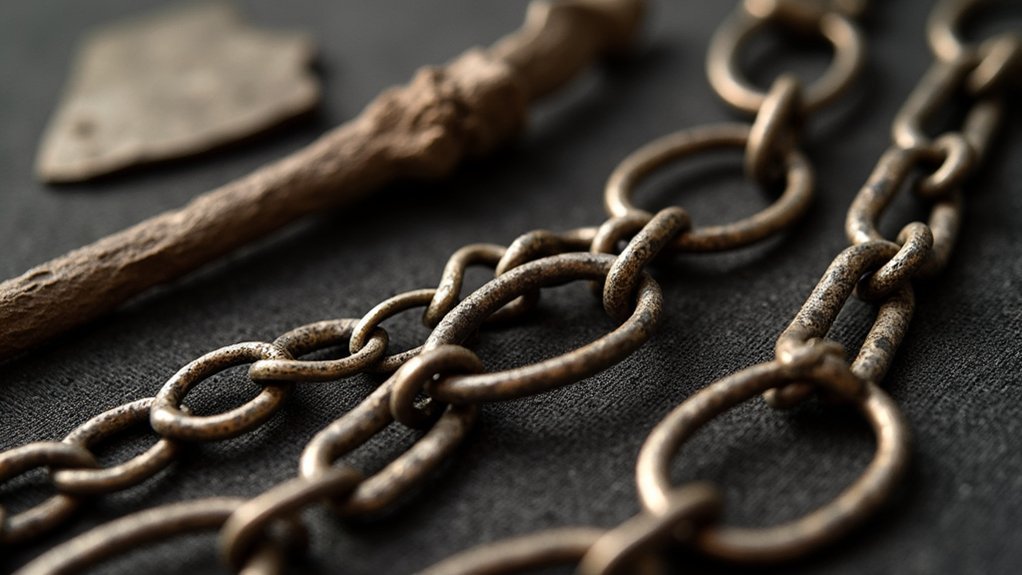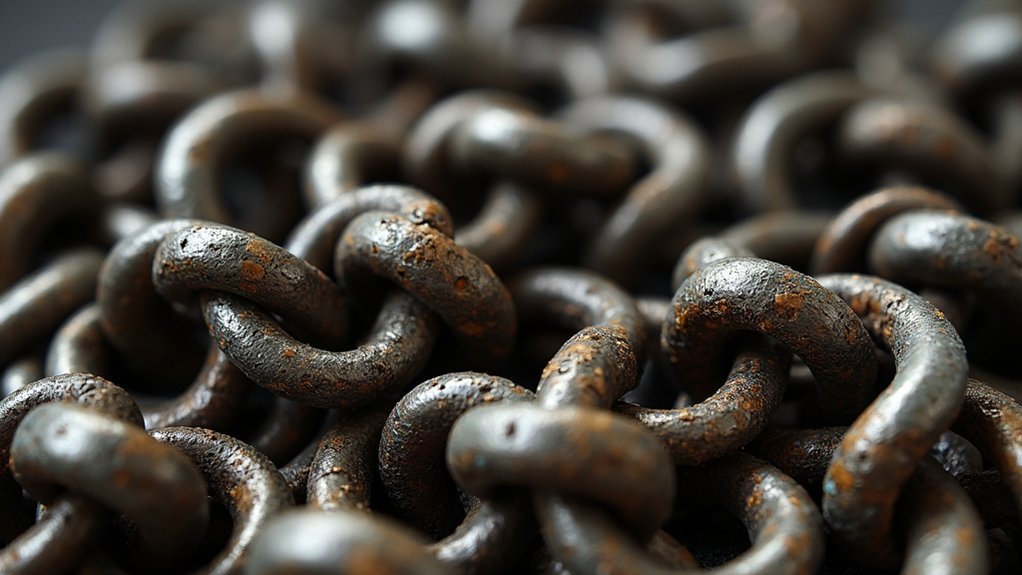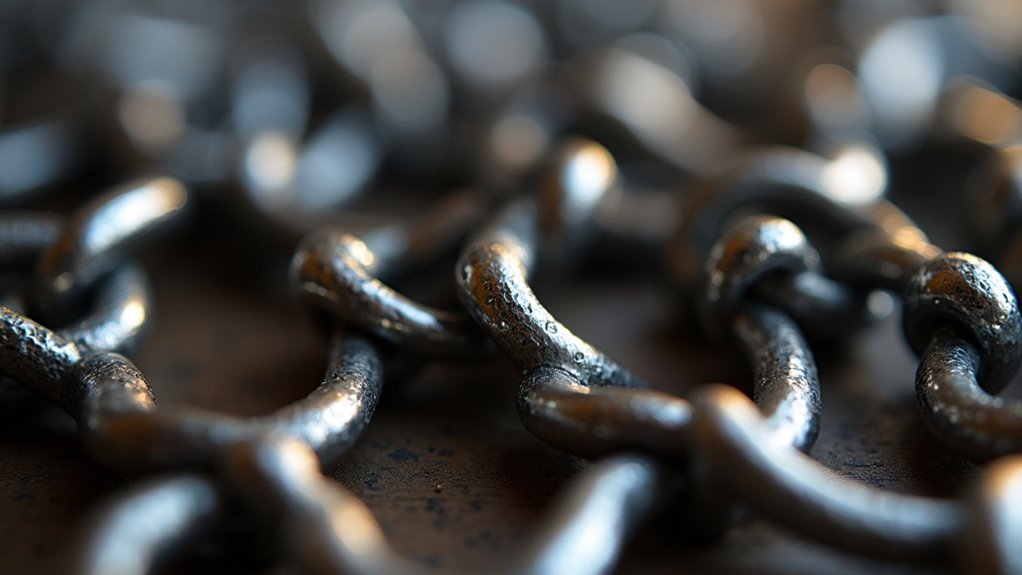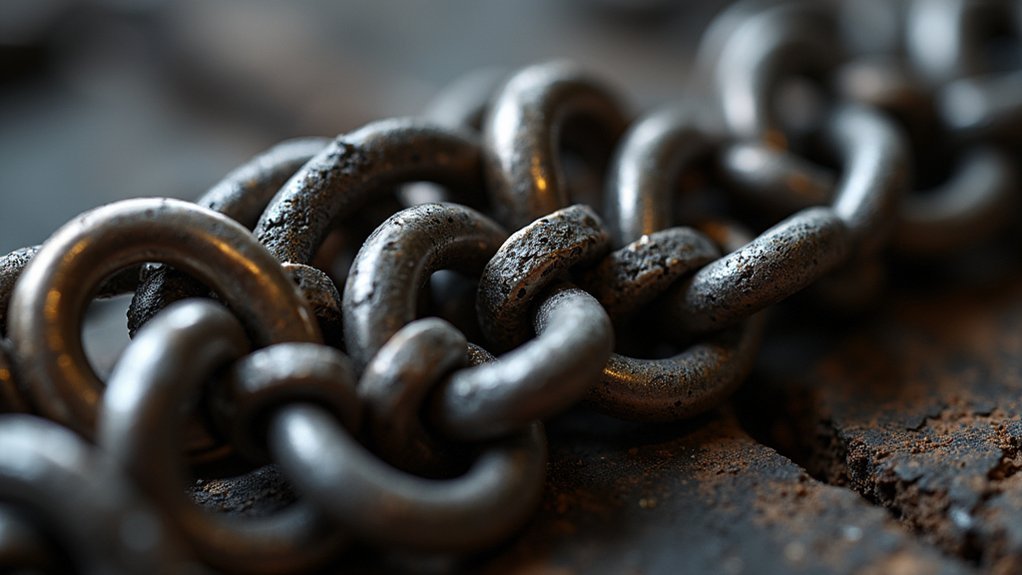You’ll achieve authentic chainmaille reconstruction by mastering the precise 4-in-1 ring pattern, where each ring interlocks with exactly four others using proper over-and-under weaving techniques. You must use historically accurate materials like 16 AWG galvanized wire with correct dimensions, while applying sophisticated conservation methods to preserve structural integrity. Don’t overlook rigorous testing through drop tests and wear simulations to validate your reconstruction’s durability and functionality. The journey toward mastering these intricate techniques reveals fascinating insights about medieval craftsmanship.
Understanding the 4-in-1 Ring Pattern Structure

When reconstructing authentic chainmaille, you’ll find that the 4-in-1 pattern forms the backbone of most historical garments, from protective coifs to full hauburks. This configuration requires each ring to interlink with exactly four others, creating a flexible yet remarkably strong structure that’s withstood centuries of battlefield testing.
You’ll start construction by closing four rings, then threading an open fifth ring through all four to establish your foundation.
Ring orientation proves critical—position one side “tilted down” with the far edge lower, while the opposite side stays “tilted up” with the far edge higher. This alignment maintains proper pattern integrity.
As you weave replacement rings, they must pass over and under existing rings while matching the established orientation.
Visualizing the complete 4-in-1 arrangement helps you identify missing links and guides accurate placement for maximum structural integrity.
Archaeological Mail Preservation Challenges
While historical chainmaille represents the pinnacle of medieval craftsmanship, archaeological specimens present formidable preservation challenges that complicate your understanding of authentic construction techniques.
You’ll encounter fragments with a high surface-area-to-volume ratio that makes them extremely vulnerable to oxidation and corrosion. When you examine archaeological mail coat remains, you’re often working with extensively damaged pieces where ring loss has compromised the original design integrity.
Variable preservation rates create fragmentary conditions that hinder accurate analysis. You’ll need to employ sophisticated conservation techniques like the filling-in method to stabilize these artifacts.
Archaeological chainmaille fragments require advanced conservation methods to overcome deterioration challenges that compromise historical analysis and interpretation.
The Novae case study demonstrates how you can use restored rings and dummy rings to reconstruct damaged sections, helping you interpret ancient military equipment more effectively than relying solely on deteriorated fragments.
Digital Modeling Techniques for Ring Reconstruction

You’ll need sophisticated ring pattern algorithms to accurately map the interlocking structure of historical chainmaille, ensuring each digital ring connects properly with its neighbors.
These algorithms must account for variations in ring diameter, wire thickness, and linking patterns found in archaeological specimens like the Vimose coat of mail.
Virtual weave simulation then brings your reconstructed rings to life, allowing you to test how the completed mail fabric drapes and moves under realistic conditions.
Ring Pattern Algorithms
Through sophisticated parameterization and computer-aided design, ring pattern algorithms create exact digital replicas of chainmaille rings that revolutionize archaeological reconstruction efforts.
You’ll find these algorithms enable precise reproduction of intricate patterns like the 4 in 1 European chainmaille armor, ensuring historical accuracy that’s essential for authentic reconstruction.
When you’re working with fragmented archaeological finds, these ring pattern algorithms become invaluable tools.
They’ll generate complete visual models from limited preserved rings, allowing you to restore damaged chainmaille pieces effectively. You can simulate the entire construction process, analyzing both structural integrity and aesthetic qualities of historical designs.
This computational approach enhances your understanding of ancient craftsmanship while facilitating accurate restoration of archaeological mail artifacts.
Virtual Weave Simulation
Virtual weave simulation transforms fragmented archaeological evidence into detailed digital reconstructions by modeling thousands of individual rings with precise geometric accuracy.
You’ll utilize parameterization and computer-aided design to create authentic digital replicas of historical mail armor like the Vimose coat from AD 150–220.
Through rigid body simulation, you can replicate the natural draping behavior of mail fabric by connecting 19,123 individual rings into accurate patterns.
This virtual weave simulation process lets you analyze structural integrity under various conditions while creating both pristine and deteriorated versions of the armor.
You’ll gain invaluable insights into original construction techniques, enhancing cultural heritage preservation through innovative archaeological technology that bridges ancient craftsmanship with modern digital modeling capabilities.
Materials Analysis and Ring Composition
When reconstructing authentic chainmaille, you’ll find that selecting the right materials forms the foundation of your entire project.
You’ll want to use 16 AWG galvanized wire with a 1/4 inch internal diameter for optimal balance between strength and rust resistance. This composition guarantees your mail armour maintains flexibility while conforming to your body without restricting movement.
You can’t overlook the importance of high-quality materials, as modern alternatives often differ greatly from historical properties.
Pay attention to surface finishes since galvanized coatings lose their shine over time, affecting visual authenticity.
Your ring connection method, particularly the 4 in 1 pattern, directly impacts both structural integrity and aesthetic appearance, making material selection vital for achieving historically accurate reconstructions.
Conservation Methods for Fragmented Artifacts

Fragmented chainmaille artifacts present unique challenges that require specialized conservation techniques to preserve both their physical integrity and historical value.
You’ll need to employ restoration methods that stabilize the mesh while maintaining authenticity. The most effective approach involves carefully preserving existing rings and strategically filling gaps.
Essential conservation techniques include:
Preserving chainmaille requires stabilizing original rings, filling structural gaps, and thoroughly documenting construction methods before beginning restoration work.
- Stabilizing preserved rings while maintaining their original structure
- Using dummy rings to fill gaps and restore mesh integrity
- Documenting original construction methods before reconstruction
- Analyzing regional styles and craftsmanship techniques
- Creating detailed records of shifts in construction patterns
Museums have successfully used filling-in techniques to reveal hidden details in damaged specimens.
The Novae, Bulgaria case study demonstrates how proper conservation greatly influences research outcomes, helping you understand ancient craftsmanship practices and regional variations in mail armor construction.
Computer Simulation of Mail Draping Behavior
You’ll need to understand how nearly 19,123 individual rings interact through rigid body simulation to accurately replicate the Vimose coat’s flexible draping behavior.
The parameterized 3D modeling creates precise digital replicas that reveal how ring interaction physics governs weight distribution and fabric movement across the garment.
Virtual reality modeling then brings these simulations to life, letting you visualize how the reconstructed chainmaille would’ve hung and fitted on its original wearer.
Ring Interaction Physics
As researchers immerse themselves in the complex world of chainmaille reconstruction, they’re discovering that rigid body dynamics form the backbone of accurate ring interaction simulations.
When you’re working with ring interaction physics, you’ll need sophisticated parameterization and 3D modeling software to handle the computational demands of nearly 20,000 individual metal rings.
Your simulation must account for:
- Weight distribution and gravitational forces affecting each ring’s position
- Contact mechanics between neighboring rings during movement
- Elasticity and deformation properties of individual metal components
- Friction coefficients that determine sliding and locking behaviors
- Dynamic response patterns under various stress conditions
These calculations help you understand how rings respond to weight and movement, revealing the flexibility and structural integrity that made historical mail armor so effective in combat scenarios.
Virtual Reality Modeling
Building on these rigid body dynamics principles, virtual reality modeling takes chainmaille reconstruction into the digital domain where you can simulate the complex draping behavior of entire mail garments.
You’ll employ parameterization and computer-aided design to create accurate digital replicas of historical pieces like the Vimose coat from AD 150–220. The process simulates interactions between 19,123 individual rings, replicating the original mail fabric’s flexibility and weight distribution patterns.
You can generate digital versions in both pristine and current preservation states, allowing thorough analysis of historical construction techniques.
This virtual reality approach preserves fragile archaeological artifacts in digital format while providing insights into ancient craftsmanship and material properties. The technology enhances understanding of mail armor construction and establishes foundations for future historical garment analysis.
Historical Vs Archaeological Mail Comparison

When you examine historical versus archaeological chainmaille, you’ll encounter two fundamentally different preservation states that dramatically affect your reconstruction approach.
Historical mail from the late medieval to early modern period typically survives in excellent condition, while archaeological specimens from the 4th or 3rd centuries BC present significant challenges.
Key differences you’ll notice include:
- Ring preservation – Historical mail retains original shape with minimal loss versus extensive ring deterioration in archaeological examples
- Construction clarity – Medieval specimens show clear linking patterns while ancient fragments require interpretive analysis
- Unique features – Archaeological pieces reveal specific techniques like diagonal hem steps found in Roman coats
- Regional variations – Comparative studies highlight evolving craftsmanship across time periods
- Restoration needs – Fill-in techniques help stabilize fragmentary archaeological weaves
Ring Replacement and Gap-Filling Strategies
When you’re reconstructing authentic chainmaille, you’ll need to master the art of identifying missing ring patterns within the traditional 4-in-1 weave structure.
You can employ dummy ring stabilization methods to temporarily hold fragments in place while determining the correct orientation and number of replacement rings needed.
These archaeological fragment restoration techniques require careful analysis of existing ring relationships to guarantee you’re maintaining historical accuracy throughout the reconstruction process.
Identifying Missing Ring Patterns
How do you accurately identify where rings are missing from a damaged chainmaille piece? The key lies in understanding the underlying structure and systematically analyzing the existing pattern.
When identifying missing ring patterns in chain mail, you’ll need to:
- Lay the piece completely flat to visualize the structural framework clearly.
- Recognize the characteristic “four rings in one ring” pattern typical of 4 in 1 chainmaille styles.
- Assess the natural direction and orientation of existing rings to determine proper placement.
- Use dummy rings as temporary placeholders to stabilize gaps and reveal the original pattern.
- Visualize the completed pattern before attempting any repairs to guarantee accuracy.
This methodical approach helps you interpret fragmented sections correctly, allowing for authentic reconstruction that maintains the garment’s historical integrity and structural soundness.
Dummy Ring Stabilization Methods
Although dummy rings serve as temporary structural supports, they’re essential for maintaining the integrity of damaged chainmaille during reconstruction. You’ll insert these replica rings into gaps within the mail structure to stabilize the mesh and prevent further deterioration. This filling-in technique helps distribute stress evenly across remaining areas while providing clearer visual representation of the original weave pattern.
| Conservation Benefit | Implementation Method |
|---|---|
| Physical Stabilization | Insert dummy rings into structural gaps |
| Stress Distribution | Place supports at key connection points |
| Pattern Reconstruction | Fill missing sections systematically |
| Shape Restoration | Maintain original garment form |
| Preservation Enhancement | Reduce risk of continued deterioration |
The Roman mail conservation at Novae demonstrates successful dummy ring application, where archaeologists reconstructed the weave and improved stability through strategic gap-filling.
Archaeological Fragment Restoration Techniques
Building upon dummy ring stabilization, you’ll need to master specific techniques for replacing damaged rings and filling structural gaps in archaeological chainmaille fragments. Your restoration success depends on understanding the original construction patterns and implementing careful replacement strategies.
When restoring archaeological mail fragments, follow these essential techniques:
- Lay the fragment flat to visualize the original 4-in-1 pattern and identify missing ring locations.
- Create replica rings that match the original wire gauge and metal composition.
- Close new rings carefully to avoid damaging existing fragile rings during installation.
- Maintain proper ring orientation and weaving technique consistent with the original pattern.
- Document each replacement to preserve archaeological integrity and research value.
This systematic approach enhances understanding of historical garment construction while revealing unique design features, as demonstrated in successful Roman mail fragment analyses from Novae, Bulgaria.
Weaving Techniques for Authentic Reconstruction
Mastery of traditional weaving techniques forms the foundation of authentic chainmaille reconstruction, with the 4 in 1 pattern serving as the backbone of European armor construction. You’ll connect each ring to four others, creating flexible yet strong structures that mirror historical designs.
Before beginning, visualize your pattern and lay pieces flat to identify the natural direction of existing rings. You’ll need two pairs of pliers—one for opening rings, another for closing them without metal damage.
| Weaving Step | Ring Orientation | Key Action |
|---|---|---|
| Assessment | Natural direction | Lay flat, identify gaps |
| Preparation | Proper alignment | Use visualization techniques |
| Installation | Over/under pattern | Follow established weave |
| Completion | Tilted positioning | Maintain structural integrity |
When adding replacement rings, weave them over and under existing rings, maintaining the established pattern for structural authenticity.
Weight Distribution and Structural Integrity

When reconstructing authentic chainmaille, you’ll discover that proper weight distribution determines whether your armor functions as intended or becomes an unwieldy burden.
Each ring in the traditional 4-in-1 pattern connects to four others, creating a framework that absorbs and distributes force throughout the garment. This interlinking design enhances structural integrity while maintaining flexibility for movement.
Consider these critical factors for ideal weight distribution:
- Ring size and type directly affect balance and stability
- Proper garment shaping allows armor to conform to your body naturally
- Even load distribution prevents strain on individual pressure points
- Strategic ring placement maintains protective capabilities without sacrificing comfort
- Thoughtful design choices keep heavy garments like the 22-pound Vimose coat functional
You’ll find that mastering these elements transforms unwieldy metal into responsive, protective armor.
Documentation Methods for Ring Patterns
Accurate documentation of ring patterns forms the foundation of successful chainmaille reconstruction, requiring systematic recording of each connection point and structural relationship. You’ll need to identify specific arrangements like the 4 in 1 pattern, where each ring connects to four others. Lay your piece flat to assess integrity and visualize missing components.
| Ring Orientation | Visual Description | Connection Count |
|---|---|---|
| Tilted Down | Lower side positioning | 4 rings maximum |
| Tilted Up | Higher side positioning | 4 rings maximum |
| Flat Position | Horizontal alignment | 2-4 connections |
| Overlapped | Interwoven placement | Variable count |
Use visual aids like diagrams to clarify orientations. Record the rings that make up each section, noting materials such as 16 AWG galvanized wire and internal diameters. Proper documentation with needle-nose pliers guarantees authentic reconstruction.
Validation Through Physical Testing
Once you’ve documented your chainmaille’s ring patterns and construction details, you must validate the reconstruction through rigorous physical testing. This vital step determines whether your coat truly matches historical performance standards.
Physical testing validates your chainmaille’s authenticity and functionality through several methods:
- Drop tests and tensile strength assessments – Evaluate material durability and construction effectiveness
- Wear tests simulating combat scenarios – Assess impact and abrasion resistance under realistic conditions
- Comparative studies against archaeological finds – Reveal insights into historical manufacturing methods and real-world applications
- Traditional weaving pattern verification – Confirm 4-in-1 patterns provide proper flexibility and functionality
- Modern material balance testing – Determine if galvanized wire maintains authenticity while offering corrosion resistance
These tests confirm whether your reconstruction withstands the same stresses medieval warriors faced in battle.
Frequently Asked Questions
Why Was Chainmail so Effective?
You’d find chainmail effective because its interlocking rings distribute impact force across wider areas, preventing blade penetration while maintaining flexibility. You can move freely while staying protected from slashing attacks.
What Was the Weakness of Chain Mail?
You’ll find chain mail’s main weaknesses were vulnerability to piercing attacks, corrosion from moisture, weight-induced fatigue, and poor protection against blunt force trauma requiring padded undergarments.
How Effective Was Chainmail Against Swords?
You’ll find chainmail highly effective against slashing sword attacks, distributing force across interlinked rings. However, you’re still vulnerable to thrusting strikes and powerful blows that transfer impact through the armor.
How Did They Make Chainmail Back in the Day?
You’d hand-forge individual iron rings by cutting coiled wire, then hammer each piece into shape. You’d interlink them using the 4-in-1 pattern, connecting each ring to four others for flexibility and protection.
In Summary
You’ll achieve authentic chainmaille reconstruction when you’ve mastered the 4-in-1 pattern structure and understood archaeological preservation challenges. You can’t skip digital modeling or materials analysis if you want accuracy. You must document every ring pattern meticulously and validate your work through physical testing. Your success depends on combining proper weaving techniques with conservation methods that maintain structural integrity. You’re reconstructing history, so you’ll need patience, precision, and respect for the original craftsmanship.





Leave a Reply